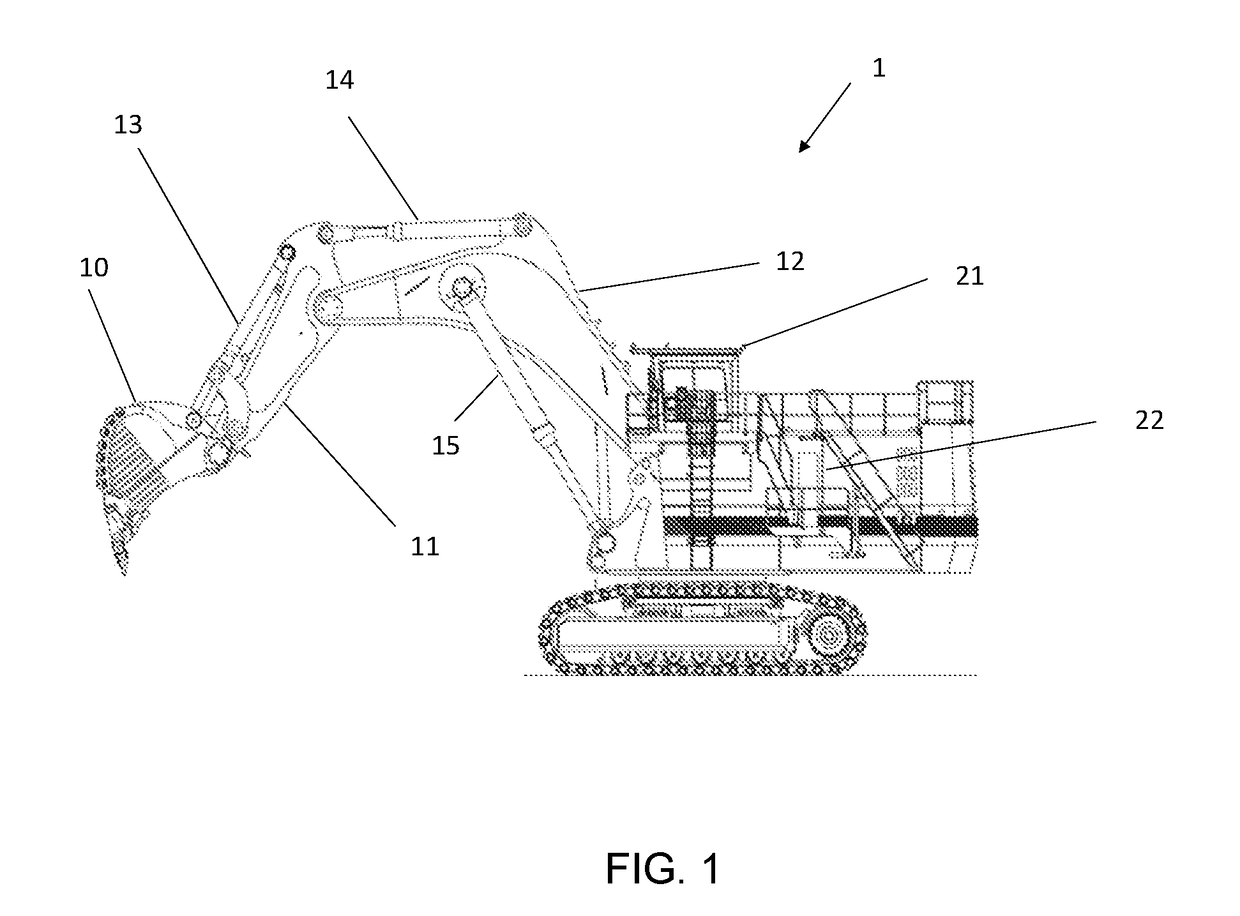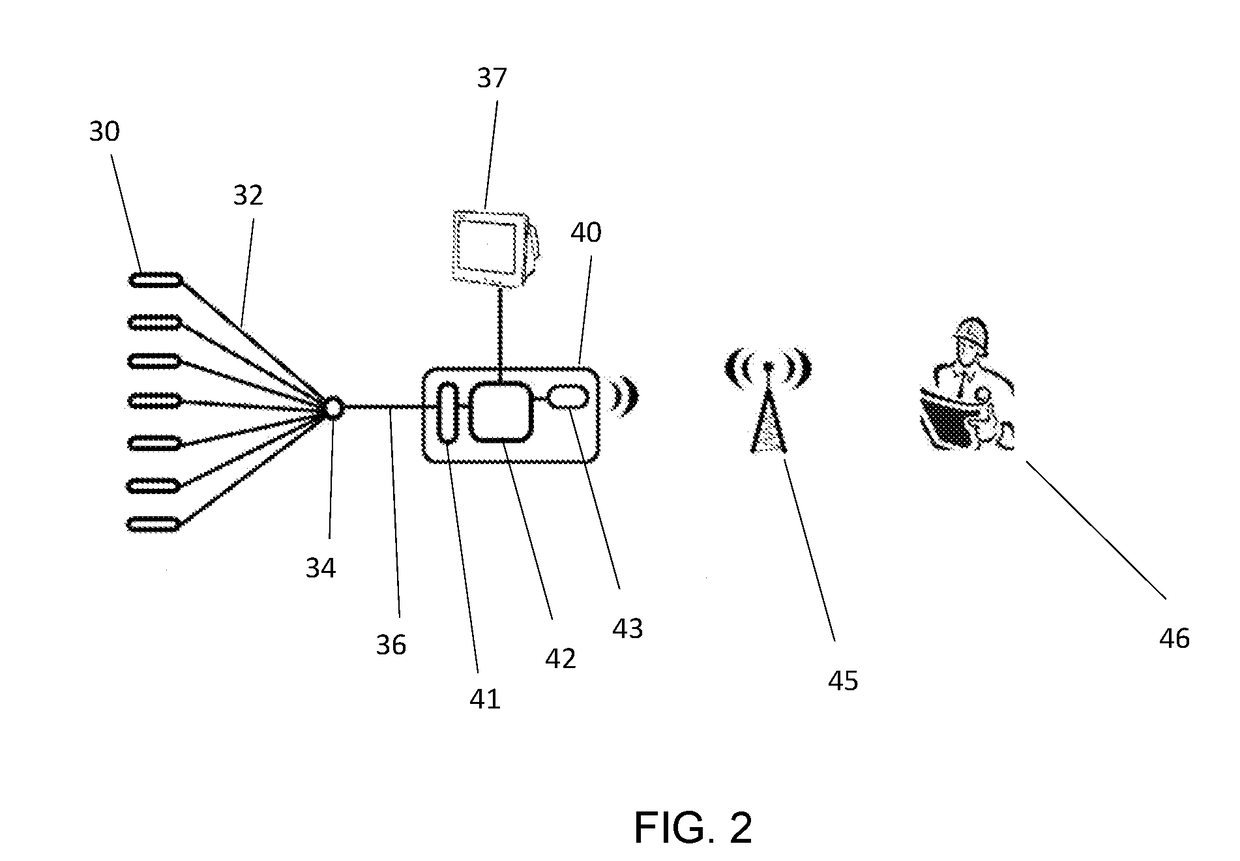Stress or accumulated damage monitoring system
a monitoring system and stress or accumulation technology, applied in the field of real-time stress and/or accumulation damage monitoring system, can solve the problems of limited use of monitoring system, affecting productivity and maintenance cost, and so as to minimize stress/cumulative damage of boom and stick, the effect of reducing the risk of catastrophic failur
- Summary
- Abstract
- Description
- Claims
- Application Information
AI Technical Summary
Benefits of technology
Problems solved by technology
Method used
Image
Examples
example 1
HITACHI EX3600 Excavator
[0054]Referring first to FIG. 1, the embodiment to be described is applied to an HITACHI EX3600 excavator 1 comprising bucket 10, stick 11 and boom 12. Boom 12 is rotatably attached to the excavator body and is driven by hydraulic piston actuator 15. Stick 11 is rotatably attached to boom 12 and is driven by hydraulic piston actuator 14. Similarly, bucket 10 is rotatably attached to stick 11 and is driven by hydraulic piston actuator 13 (also referred to herein as a stick actuator). Excavator body has driver's cabin 21 atop engine room 22.
[0055]Referring also now to FIGS. 2 and 3, a plurality of sensors 30 are distributed over boom and stick, including piezoelectric strain gauges, pressure sensors and inclinometers. The strain gauges 52-60 are located at strain gauge locations determined by detailed analysis (described in more detail later) as the most critical locations on the boom and stick that can be used to accurately estimate the stress or cumulative da...
example 2
Trucks
[0091]Two embodiments applicable to a CATERPILLAR CAT793 C or D 240 tonne truck and a CAT 797 B or C 360 tonne truck will now be described together.
[0092]With currently available truck fatigue systems, the fatigue Life is based on measurements of all criteria (Racking+Pitching+Rolling) as measured from strut pressures, and producing a fatigue life prediction for the entire chassis, not for specific areas. In reality, the fatigue life will vary significantly from location to location, depending on the stress range, number stress cycles experienced and the fatigue category detail of the welded connection. The various locations on the chassis will also experience more or less damage due to the specific operating conditions such as rack, pitch, roll and bounce. Having one curve applied to all locations of the chassis can be extremely conservative or in some cases would be non-conservative.
[0093]Referring now to FIGS. 5a and 5b, a chassis of the CAT 793 C or D truck is shown in two...
example 3
Electric Rope Shovels
[0118]With electric rope shovels, a key goal of the monitoring system is typically to minimize the damage on the boom and dipper handle. However monitoring of the dipper handle is not possible because it slides within the boom saddle block. Hence it is extremely difficult to locate sensors on the handles. This difficulty is overcome by locating sensors on critical locations on the boom to derive the fatigue that the boom experiences and this can be used from the FEA modelling to infer damage occurring in the dipper handle. Lateral bending of the dipper handles during operations (swing with the dipper engaged in dirt) contribute significantly to the most common failure mode of the dipper handles.
[0119]As with the previous examples on excavators and trucks, the system applied to shovels can alarm the operator when the peak stresses / fatigue damage reaches derived limits for the different conditions the shovels experiences during operations.
[0120]Recent upgrades int...
PUM
 Login to View More
Login to View More Abstract
Description
Claims
Application Information
 Login to View More
Login to View More - R&D
- Intellectual Property
- Life Sciences
- Materials
- Tech Scout
- Unparalleled Data Quality
- Higher Quality Content
- 60% Fewer Hallucinations
Browse by: Latest US Patents, China's latest patents, Technical Efficacy Thesaurus, Application Domain, Technology Topic, Popular Technical Reports.
© 2025 PatSnap. All rights reserved.Legal|Privacy policy|Modern Slavery Act Transparency Statement|Sitemap|About US| Contact US: help@patsnap.com



